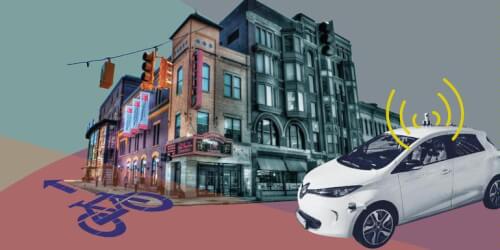Transportation — how we get from one place to another — is changing at a rapid pace. From a largely vehicle-based system comes new efforts to diversify transportation that are gaining more traction in urban and rural areas across the country.
Several Grand Valley alumni are helping lead this revolution, working to change how people move as they work, play, shop and relax.
According to transportation planners like Carolyn Ulstad, ’11, knowing what alternative transportation methods people would use is critical to ensuring the long-term success of any plan that attempts to reduce traffic and parking congestion.
Ulstad is a program assistant for the Macatawa Area Coordinating Council (MACC) and helps plan the future of transportation in the Holland area.

“We're working toward a future where car ownership is optional, where cities are designed for people instead of cars.”
PETER SAUER, '09
For example, she said MACC is working with the local bus service to develop plans to expand an already growing network of non-motorized pathways and access points for cyclists and pedestrians. MACC leaders are also promoting carpool programs and, generally, trying to make moving around the area efficient.
“We have a long-range plan that focuses on all modes of transportation, and the real goal is to find out through surveys and data collection what it is that people want, and how that lines up with trends that we see coming through in the industry,” Ulstad said.
Other transportation professionals agree that the public is pushing for more versatile means of getting around local communities and to other points in Michigan. Jim Bruckbauer, ’07, is the deputy director of the Groundwork Center for Resilient Communities and said the demand for new modes of transit and transportation is growing.
“You can see through polling data that’s been collected over the years that we’re ready for new ways to get around the state,” Bruckbauer said. “People tell us they want to see better mass transit, better passenger rail, and more options to get around once they get across the state to a different city.”
Bruckbauer is working on transportation policy, specifically focusing on passenger rail. He said there is significant opportunity to invest in that particular mode of transportation because the infrastructure already exists.
“We’re specifically focusing on bringing passenger rail from Ann Arbor to Traverse City, and also using the Traverse City region as a model for other communities in terms of adding mobility options like car-share, ride-share and bike-share as options for how to get around once you arrive in a city,” Bruckbauer said.
Both Bruckbauer and Ulstad are focused on sustainability, both environmental and economic. They said working to reduce the number of vehicles on the road and vehicle emissions is a significant factor, and having improved transit options is a positive in terms of economic growth.
“A big part of this is talent attraction. Business leaders are supporting transit because they see it as a way to attract the next generation of talent that wants to live and thrive in Michigan without having to depend on a car to get around,” Bruckbauer said.
One way for next-generation talent to get around is using ride-share apps like Uber or Lyft, which are becoming increasingly available even in small metropolitan areas like Holland.
Peter Sauer, ’09, is a product manager at Lyft and said the company is fundamentally changing the way people think about car ownership and transportation.
“We’re working toward a future where car ownership is optional, where cities are designed for people instead of cars, where traffic disappears, and where people come together instead of being isolated as one person per car,” Sauer said.
The future of how we move from place to place will likely look very different. Sauer said Lyft is working toward a network of shared, autonomous, electric vehicles that will play a central role in creating wholesale changes to major cities and physical environments.
Bruckbauer said the changes he expects in the future will be driven by cultural changes and how people want to use their time.
“People want less and less to spend a lot of time driving. They want to be on their devices, or spending time working, or being social,” he said. “If you don’t have to drive, it lets you do so many more things. That perception change, particularly among young people, is driving this evolution.”






